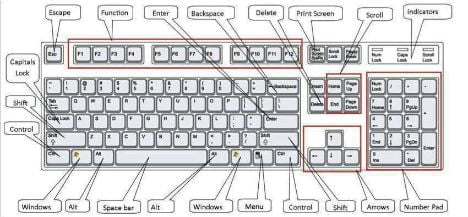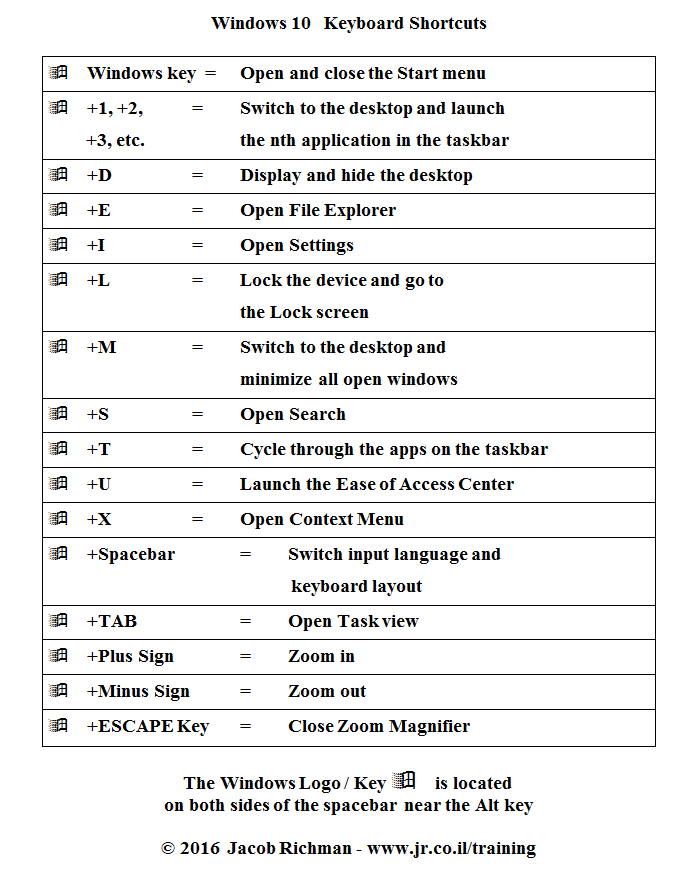

- #All windows keyboard shortcuts windows 10#
- #All windows keyboard shortcuts plus#
- #All windows keyboard shortcuts windows 7#
To open the File Explorer window, simply press the Windows button ⊞ + E.
#All windows keyboard shortcuts windows 10#
These will work for both Windows 10 and Windows 11. Useful when the Remote Desktop controls are embedded in another (host) program.Watch on YouTube & Subscribe to our Channel 12 Keyboard Shortcutsīelow are 12 of my favorite keyboard shortcuts to use when working with Windows File Explorer. €œTab†out of the Remote Desktop controls to a control in the host program (for example, a button or a text box). Place a copy of the entire client window area on the Terminal server clipboard (provides the same functionality as pressing PrtScn on a local computer). Place a copy of the active window, within the client, on the Terminal server clipboard (provides the same functionality as pressing Alt+PrtScn on a local computer).Ĭtrl+Alt+Plus Sign (+) on the numeric keypad Move between programs from right to left.Ĭycle through programs in the order that they were started in.Ĭtrl+Alt+Minus Sign (-) on the numeric keypad Move between programs from left to right.
#All windows keyboard shortcuts plus#
Windows logo key + Plus Sign or Minus Sign Shift+Right-click on a grouped taskbar button Open a program or quickly open another instance of a program Open the Properties dialog box for the selected itemĭisplay the current selection (if it's collapsed), or select the first subfolderĭisplay all folders above the selected folderĬhange the size and appearance of file and folder icons Num Lock+Minus Sign (-) on numeric keypadĬollapse the current selection (if it's expanded), or select the parent folder Move a window from one monitor to another.ĭisplay all subfolders under the selected folderĭisplay the contents of the selected folder Windows logo key +Shift+Left Arrow or Right Arrow Stretch the window to the top and bottom of the screen. Maximize the window to the right side of the screen. Maximize the window to the left side of the screen. Switch to the program that displayed a message in the notification area. Use the arrow keys to cycle through programs on the taskbar by using Aero Flip 3-D. Open the Jump List for the program pinned to the taskbar in the position indicated by the number.Ĭycle through programs on the taskbar by using Aero Flip 3-D. Switch to the last active window of the program pinned to the taskbar in the position indicated by the number. Start a new instance of the program pinned to the taskbar in the position indicated by the number. If the program is already running, switch to that program. Start the program pinned to the taskbar in the position indicated by the number. Search for computers (if you're on a network). Restore minimized windows to the desktop. Open a folder one level up if a folder is selected in the Save As or Open dialog boxĭisplay the System Properties dialog box. Select a button if the active option is a group of option buttons Select or clear the check box if the active option is a check box Replaces clicking the mouse for many selected commands Perform the command (or select the option) that goes with that letter Switch the keyboard layout when multiple keyboard layouts are enabledĬhange the reading direction of text in right-to-left reading languages

Switch the input language when multiple input languages are enabled Prevent the CD from automatically playing View the folder one level up in Windows Explorer Open the next menu to the left, or close a submenu Open the next menu to the right, or open a submenu Perform the menu command (or other underlined command)Īctivate the menu bar in the active program Use the arrow keys to cycle through programs on the taskbar by using Aero Flip 3-DĬycle through items in the order in which they were openedĬycle through screen elements in a window or on the desktopĭisplay the address bar list in Windows Explorerĭisplay the shortcut menu for the selected item Use the arrow keys to switch between open itemsĬycle through programs on the taskbar by using Aero Flip 3-D Open the shortcut menu for the active windowĬlose the active document (in programs that allow you to have multiple documents open simultaneously) Select multiple individual items in a window or on the desktopĬlose the active item, or exit the active program Select more than one item in a window or on the desktop, or select text within a document Move the cursor to the beginning of the previous paragraph Move the cursor to the beginning of the next paragraph Move the cursor to the beginning of the previous word Move the cursor to the beginning of the next word
#All windows keyboard shortcuts windows 7#
Windows 7 Keyboard Shortcuts - printable cheatsheet Windows 7 Keyboard Shortcutsĭelete the selected item and move it to the Recycle Binĭelete the selected item without moving it to the Recycle Bin first


 0 kommentar(er)
0 kommentar(er)
